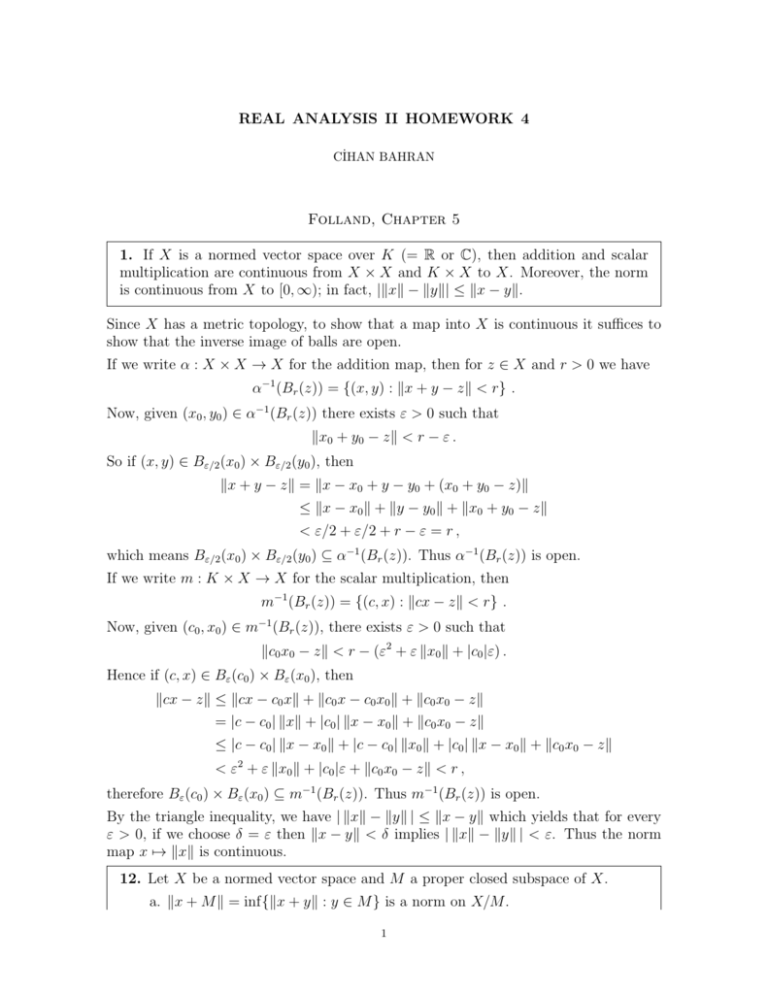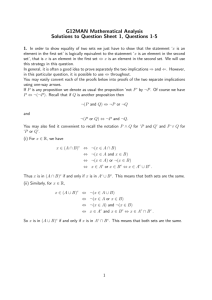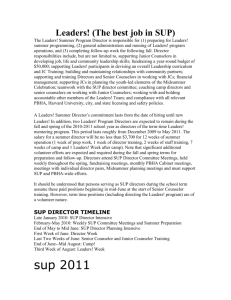REAL ANALYSIS II HOMEWORK 4 Folland, Chapter 5 1. If X is a
advertisement

REAL ANALYSIS II HOMEWORK 4
CİHAN BAHRAN
Folland, Chapter 5
1. If X is a normed vector space over K (= R or C), then addition and scalar
multiplication are continuous from X × X and K × X to X. Moreover, the norm
is continuous from X to [0, ∞); in fact, |kxk − kyk| ≤ kx − yk.
Since X has a metric topology, to show that a map into X is continuous it suffices to
show that the inverse image of balls are open.
If we write α : X × X → X for the addition map, then for z ∈ X and r > 0 we have
α−1 (Br (z)) = {(x, y) : kx + y − zk < r} .
Now, given (x0 , y0 ) ∈ α−1 (Br (z)) there exists ε > 0 such that
kx0 + y0 − zk < r − ε .
So if (x, y) ∈ Bε/2 (x0 ) × Bε/2 (y0 ), then
kx + y − zk = kx − x0 + y − y0 + (x0 + y0 − z)k
≤ kx − x0 k + ky − y0 k + kx0 + y0 − zk
< ε/2 + ε/2 + r − ε = r ,
which means Bε/2 (x0 ) × Bε/2 (y0 ) ⊆ α−1 (Br (z)). Thus α−1 (Br (z)) is open.
If we write m : K × X → X for the scalar multiplication, then
m−1 (Br (z)) = {(c, x) : kcx − zk < r} .
Now, given (c0 , x0 ) ∈ m−1 (Br (z)), there exists ε > 0 such that
kc0 x0 − zk < r − (ε2 + ε kx0 k + |c0 |ε) .
Hence if (c, x) ∈ Bε (c0 ) × Bε (x0 ), then
kcx − zk ≤ kcx − c0 xk + kc0 x − c0 x0 k + kc0 x0 − zk
= |c − c0 | kxk + |c0 | kx − x0 k + kc0 x0 − zk
≤ |c − c0 | kx − x0 k + |c − c0 | kx0 k + |c0 | kx − x0 k + kc0 x0 − zk
< ε2 + ε kx0 k + |c0 |ε + kc0 x0 − zk < r ,
therefore Bε (c0 ) × Bε (x0 ) ⊆ m−1 (Br (z)). Thus m−1 (Br (z)) is open.
By the triangle inequality, we have | kxk − kyk | ≤ kx − yk which yields that for every
ε > 0, if we choose δ = ε then kx − yk < δ implies | kxk − kyk | < ε. Thus the norm
map x 7→ kxk is continuous.
12. Let X be a normed vector space and M a proper closed subspace of X.
a. kx + M k = inf{kx + yk : y ∈ M } is a norm on X/M .
1
REAL ANALYSIS II HOMEWORK 4
b.
c.
d.
e.
2
For any ε > 0 there exists x ∈ X such that kxk = 1 and kx + M k ≥ 1 − ε.
The projection map π(x) = x + M from X to X/M has norm 1.
If X is complete, so is X/M . (Use Theorem 5.1.)
The topology defined by the quotient norm is the quotient topology as
defined in the exercise 28 in §4.2.
a. First of all note that the definition of kx + M k only depends on the coset, not
the representative x. Indeed, kx + M k = inf{kzk : z ∈ x + M }. Observe that given
x, y ∈ X and z ∈ M we have
k(x + y) + M k ≤ k(x + y) + zk ≤ kx + zk + kyk .
So k(x + y) + M k − kyk is a lower bound for the set {kx + zk : z ∈ M }. Therefore
k(x + y) + M k − kyk ≤ kx + M k and hence
k(x + y) + M k ≤ kx + M k + kyk .
For every z ∈ M , replacing y with y + z above yields
k(x + y) + M k = k(x + y + z) + M k ≤ kx + M k + ky + zk .
So k(x + y) + M k − kx + M k is a lower bound for the set {ky + zk : z ∈ M }. Therefore
k(x + y) + M k − kx + M k ≤ ky + M k and hence
k(x + M ) + (y + M )k = k(x + y) + M k ≤ kx + M k + ky + M k .
This proves the triangle inequality.
Second, let x ∈ X and λ ∈ K. If λ = 0, then
kλ(x + M )k = k0 + M k = inf{kyk : y ∈ M } = 0 = |λ| kx + M k
since 0 ∈ M . If λ 6= 0, then λM = M so
kλ(x + M )k = kλx + M k
= inf{kλx + yk : y ∈ M }
= inf{kλx + λyk : y ∈ M }
= inf{|λ| kx + yk : y ∈ M }
= |λ| inf{kx + yk : y ∈ M }
= |λ| kx + M k .
Thus we have a seminorm on X/M . To see that this is a norm, suppose kx + M k = 0.
This yields that
d(x, M ) = inf{kx − yk : y ∈ M } = 0 .
Since M is closed this implies that x ∈ M , so x + M = 0 + M .
c. Let x ∈ X − M , so kx + M k > 0. Given α ∈ (0, 1), since α−1 kx + M k > kx + M k
there exists y ∈ M such that
α−1 kx + M k > kx + yk .
Write z = x + y. Then since x + M = z + M = π(z), we get
kπ(z)k
> α,
kzk
REAL ANALYSIS II HOMEWORK 4
3
therefore kπk > α. As this holds for every α ∈ (0, 1) we get kπk ≥ 1. On the other
hand, for every x ∈ X we have kπ(x)k = kx + M k ≤ kxk by choosing y = 0. Thus
kπk = 1.
b. By (c) we have
1 = kπk = sup{kx + M k : kxk = 1} .
So for every ε > 0 there exists x with kxk = 1 such that kx + M k > 1 − ε.
d. Assume X is complete. Let
∞
X
(xn + M ) be an absolutely convergent series in X/M .
n=1
For every n, choose yn ∈ M such that
kxn + yn k < kxn + M k +
1
.
n2
So
∞
X
∞
X
π2
< ∞.
kxn + yn k ≤
kxn + M k +
6
n=1
n=1
In other words,
∞
X
(xn + yn ) is an absolutely convergent series in X. Since X is com-
n=1
plete, by Theorem 5.1 the series converges. That is, if we write
sN =
N
X
(xn + yn )
n=1
then {sN } is a convergent sequence in X, say limN →∞ sN = s. Note that
π(sN ) = π
N
X
!
(xn + yn ) =
n=1
N
X
π(xn ) =
n=1
N
X
(xn + M )
n=1
as π(yn ) = 0. Finally since π is continuous by (c), we conclude that
∞
X
(xn + M ) = lim π(sN ) = π(s) = s + M .
n=1
N →∞
Thus again by Theorem 5.1 X/M is complete.
e. As π is evidently a surjection, it suffices to show that π is an open map. If X is
Banach, then so is X/M by (d) so we can immediately conclude by the open mapping
” be the completion of X. Then we may identify the
theorem. For the general case, let X
d of M with the closure of M inside X.
” As X embeds in X
” isometrically,
completion M
”M
d. In fact there is a commutative diagram
so does X/M in X/
X
π
X/M
i
j
”
/X
b
π
”M
d
/ X/
” and X/
”M
d is complete.
where i and j are isometrical embeddings and πb is open since X
”
This forces π to be open: if U is open in X, then i(U ) is open in X so πb (i(U )) = j(π(U ))
”M
d. But j is an isometrical embedding, so π(U ) is open in X/M .
is open in X/
REAL ANALYSIS II HOMEWORK 4
4
17. A linear functional f on a normed vector space X is bounded iff f −1 ({0}) is
closed. (Use Exercise 12b).
If f is bounded, then f is continuous so f −1 ({0}), being the inverse image of a singleton
in a metric space, is closed. Conversely, suppose M = f −1 ({0}) is closed. As a linear
map, f factors through X/M , that is f = g ◦ π where π : X → X/M is the projection
map and g : X/M → K is given by g(x + M ) = f (x). Here is g is injective as we are
factoring out the kernel of f . So g is a linear map between finite-dimensional spaces,
hence g is bounded. Because M is closed Exercise 12 applies and we get that π is
bounded. Thus f is bounded.
25. If X is a Banach space and X ∗ is separable, then X is separable. (Let {fn }∞
1
be a countable dense subset of X ∗ . For each n choose xn ∈ X with kxn k = 1 and
|fn (xn )| ≥ 21 kfn k. Then the linear combinations of {xn }∞
1 are dense in X.) Note:
∗
Separability of X does not imply separability of X .
We may assume fn ’s are nonzero. Since 21 kfn k < kfn k = sup{|fn (x)| : kxk = 1} for
every n there exists xn with kxn k = 1 such that |fn (xn )| > 12 kfn k. Consider the closed
subspace
M = span{xn : n ∈ N}
of X. We want to show M = X, so suppose not. Then there exists x ∈ X − M so
by Hahn-Banach theorem there exists f ∈ X ∗ such that f (x) 6= 0 and f |M = 0. Since
∗
{fn }∞
1 is dense in X there exists a subsequence {fnk } with
lim fnk = f .
k→∞
But |(fnk − f )(xnk )| = |fnk (xnk )| >
that
1
2
kfnk k so kfnk − f k >
1
2
kfnk k thus we conclude
kf k = lim kfnk k = 0
k→∞
so f = 0, contradicting f (x) 6= 0.
27. There exist meager subsets of R whose complements have Lebesgue measure
zero.
Let {qk } be an enumeration of the rational numbers and let
En =
∞
[
k=1
Consider the set E =
T∞
n=1
Ç
qk −
1
2k−1 n
, qk +
1
2k−1 n
å
.
En . Observe that
m(En ) ≤
∞
X
1
k=1
2k n
=
1
n
hence m(E) = 0.
On the other hand, we claim that for every n the complement Enc is a nowhere dense
subset of R. Indeed, since En is open Enc is closed; so it suffices to show that Enc has
empty interior. This is the case because otherwise Enc would contain an interval and
REAL ANALYSIS II HOMEWORK 4
5
hence contain a rational number, yet Q ⊆ En . Thus
Ec =
∞
[
Enc
n=1
is meager.
30. Let Y = C([0, 1]) and X = C 1 ([0, 1]), both equipped with the uniform norm.
a. X is not complete.
b. The map (d/dx) : X → Y is closed (see Exercise 9) but not bounded.
a. For every n, consider the function
fn : [0, 1] → R
x 7→
x −
n+1
1 2
n
Clearly we have
fn0 : [0, 1] → R
x 7→
Ä
ä1
n+1 x − 1 n ,
n
2
Ä
ä1
− n+1
n
1
2
−x
n
x>
, x<
1
2
1
2
For 1/2, we have
Ç å
fn0+
1
2
n+1
1
|h| n
= lim+
= lim h n = 0
h→0
h→0
h
and similarly fn0− (1/2) = 0 so fn0 (1/2) = 0. Thus fn0 is continuous at 0. Also fn0 is
obviously continuous everywhere else, so each fn is in C 1 ([0, 1]).
Observe that {fn } is a family of monotonically decreasing functions with the pointwise
limit f (x) = |x − 21 |. Thus by Dini’s theorem fn ’s converge to f uniformly. But f is not
in C 1 ([0, 1]). In other words, {fn } is a sequence in X which converges to f ∈ Y − X.
Thus X is not complete.
b. Let D be a closed subset of C 1 ([0, 1]). Suppose {fn } is a sequence in D such that
fn0 → g ∈ C([0, 1]) uniformly. Because D is compact, fn has a convergent subsequence,
so we may assume fn → f uniformly for some f . Then by Exercise 9b, f 0 = g and this
shows that the image of D under d/dx is closed.
To see (d/dx) is not bounded, let
gn : [0, 1] → R
x 7→ sin(nx) .
Clearly {gn } is a sequence in C 1 ([0, 1]) with each member having uniform norm 1. But
kgn0 k∞ = n so (d/dx) is not bounded.
40. (The Principle of Condensation of Singularities) Let X and Y be Banach
spaces and {Tjk : j, k ∈ N} ⊆ L(X, Y ). Suppose that for each k there exists x ∈ X
such that sup{kTjk xk : j ∈ N} = ∞. Then there is an x (indeed, a residual set of
x’s) such that sup{kTjk xk : j ∈ N} = ∞ for all k.
REAL ANALYSIS II HOMEWORK 4
6
For every j, k, N ∈ N define
Ej,k,N = {x ∈ X : kTjk xk ≤ N } .
Note that
[ \
Ej,k,N = {x ∈ X : sup{kTjk xk : j ∈ N} < ∞}
N ∈N j∈N
so
Ñ
{x ∈ X : sup{kTjk xk : j ∈ N} = ∞ for all k} =
[ \
k∈N
N ∈N j∈N
Ñ
=
éc
\
[ [ \
Ej,k,N
éc
Ej,k,N
.
k∈N N ∈N j∈N
Therefore it suffices to show that for every k, N ∈ N, the set
Ek,N =
\
Ej,k,N
j∈N
is nowhere dense. Note that because Tjk and the norm map are continuous, each Ej,k,N
is closed. Thus each Ek,N is closed. So we need to show that Ek,N has empty interior.
To that end, let y ∈ Ek,N and ε > 0. By assumption, there exists x ∈ X such that
sup{kTjk xk : j ∈ N} = ∞. Note that for every nonzero scalar λ,
sup{kTjk (λx)k : j ∈ N} = sup{|λ|Tjk (x) : j ∈ N}
= |λ| sup{kTjk xk : j ∈ N} = |λ|∞ = ∞
ε
so by choosing λ = 2kxk
(obviously x 6= 0) and replacing x with λx we may assume
that kxk < ε. On the other hand, for every R > 0 there exists j ∈ N such that
kTjk (x)k > R + N , so
kTjk (x − y)k = kTjk (x) − Tjk (y)k ≥ kTjk (x)k − kTjk (y)k > (R + N ) − N = R
hence
sup{kTjk (x − y)k : j ∈ N} = ∞ .
Finally, because ky − (y − x)k = kxk < ε we conclude that there exists a point (namely
y − x) outside Ek,N which lies in the ε-ball around y. Since this holds for every y ∈ Ek,N
and ε > 0, Ek,N has empty interior.
47. Suppose X and Y are Banach spaces.
a. If {Tn }∞
1 ⊆ L(X, Y ) and Tn → T weakly (or strongly), then supn kTn k < ∞.
b. Every weakly convergent sequence in X, and every weak*-convergent sequence in X ∗ , is bounded (with respect to the norm).
a. By the uniform boundedness principle (which is applicable because X is Banach),
it suffices to show that for every x ∈ X we have supn kTn (x)k < ∞. So fix x ∈ X.
By assumption we have Tn x → T x in the weak topology of Y . We conclude by taking
yn = T xn in the following lemma:
Lemma 1. Let {yn } be a weakly convergent sequence in a Banach space Y . Then
sup{kyn k : n ∈ N} < ∞.
REAL ANALYSIS II HOMEWORK 4
7
Proof. Let E : Y → Y ∗∗ be the canonical embedding. Say yn → y weakly. Then for
every f ∈ Y ∗ , we have
E(yn )(f ) = f (yn ) → f (y) = E(y)(f ) .
Hence for every f , we have sup{kE(yn )(f )k : n ∈ N} < ∞. By the uniform boundedness
principle (Y ∗ is Banach) and the fact that E is an isometry, we get
sup{kyn k : n ∈ N} = sup{kE(yn )k : n ∈ N} < ∞ .
b. The above lemma is a solution to the first part. For the second part, let {fn }
be a weak*-convergent sequence in X ∗ . This means that for every x ∈ X we have
fn (x) → f (x). Thus fn → f weakly in L(X, K) = X ∗ , so sup{kfn k} < ∞ by (a). 53. Suppose that X is a Banach space and {Tn }, {Sn } are sequences in L(X, X)
such that Tn → T strongly and Sn → S strongly.
a. If {xn } ⊆ X and kxn − xk → 0, then kTn xn − T xk → 0. (Use Exercise
47a).
b. Tn Sn → T S strongly.
a. By Exercise 47a, we have supn kTn k < ∞. Note that
kTn xn − T xk ≤ kTn xn − Tn xk + kTn x − T xk
≤ kTn k kxn − xk + kTn x − T xk
≤ sup kTn k kxn − xk + kTn x − T xk .
n
Now kxn − xk → 0 by assumption and kTn x − T xk → 0 since Tn → T strongly. Thus
kTn xn − T xk → 0 as well.
b. For every x ∈ X, we have kSn x − Sxk → 0 since Sn → S strongly. As Tn → T
strongly, by (a) we have
kTn (Sn x) − T (Sx)k = kTn Sn x − T Sxk → 0 .
This holds for every x ∈ X, hence Tn Sn → T S strongly.
p
15. (The Vitali Convergence Theorem) Suppose 1 ≤ p < ∞ and {fn }∞
1 ⊆ L .
In order for {fn } to be Cauchy in the Lp -norm it is necessary and sufficient for the
following three conditions to hold: (i) {fn } is Cauchy in measure; (ii) the sequence
{|fn |p } is uniformly integrable (see Exercise 11
in §3.2); and (iii) for every ε > 0
R
there exists E ⊆ X such that µ(E) < ∞ and E c |fn |p < ε for all n.
Assume that {fn } is Cauchy in the Lp -norm. Fix ε > 0 and for every m, n ∈ N let
Em,n = {x ∈ X : |fn (x) − fm (x)| ≥ ε}
Note that
µ(Em,n )εp =
Å
So µ(Em,n ) ≤
Z
εp dx ≤
Em,n
ãp
kfn −fm kp
ε
Z
Em,n
Ä
|fn (x) − fm (x)|p dx ≤ kfn − fm kp
äp
.
→ 0 as m, n → ∞ because {fn } is Cauchy in the Lp -norm.
Since this holds for every ε > 0, we conclude that {fn } is Cauchy in measure.
To show (ii), first note that since Lp is complete, we have fn → f in Lp for some f .
Now we claim that |fn |p → |f |p in the L1 -norm, from here it follows from Exercise 11
in §3.2 that {|fn |p } is uniformly integrable.
REAL ANALYSIS II HOMEWORK 4
8
Note that for every a, b ∈ R with a < b, applying the mean value theorem to the
function g(x) = xp we have
b p − ap
= pcp−1
b−a
for some c ∈ (a, b). Since p − 1 ≥ 0, we get
bp − ap ≤ (b − a)pbp−1 .
And in general if we don’t assume a < b, we have
|ap − bp | ≤ p|a − b| max{|a|p−1 , |b|p−1 }
≤ p|a − b|(|a| + |b|)p−1 .
Using this and Hölder’s inequality, we get
p
p
k |fn | − |f | k1 =
Z
p
p
||fn | − |f | | ≤ p
Z
|fn − f | · (|fn | + |f |)p−1
= p (fn − f )(|fn | + |f |)p−1 1
p−1 p kfn − f kp · (|fn | + |f |) q
≤
where
1
p
+
1
q
= 1. So q =
p
p−1
and hence
ÅZ
(|fn | + |f |)p−1 (|fn | + |f |)q(p−1)
=
q
ÅZ
p
ã1/q
ã1/q
(|fn + |f |)
=
ÇÅZ
p
ã1/p åp/q
(|fn | + |f |)
=
Ä
äp/q
Ä
äp/q
= k |fn | + |f | kp
≤ kfn kp + kf kp
Thus
Ä
k |fn |p − |f |p k1 ≤ p kfn − f kp · kfn kp + kf kp
äp/q
→0
since kfn − f kp → 0.
To show
(iii), since |f |p ∈ L1 , given ε > 0, there exists a set E of finite measure such
R
that E |f |p < ε/2. We established above that k |fn |p − |f |p k1 → 0, so we have
Z
Ec
p
|fn | →
Z
Ec
|f |p .
Therefore there exists N ∈ N such that for n ≥ N we have E c |fn |p < ε. And since
|f1 |p , . . . |fN −1 |p are in L1 , there exists sets E1 , . . . , EN −1 of finite measure such that
R
Z
c
En
|fn |p < ε
for n < N . So letting D = E1 ∪ · · · EN −1 ∪ E, we have that D is a set of finite measure
such that
Z
Dc
for every n ∈ N.
|fn |p < ε
REAL ANALYSIS II HOMEWORK 4
9
We have established the necessity of the three conditions. Now assume (i),(ii),(iii) hold.
Fix ε > 0. Then by (iii) there exists a set E of finite measure such that for all n we
have kχE c fn kp < ε/6. Therefore
kχE c (fm − fn )kp ≤ kχE c fm kp + kχE c fn kp ≤ ε/6 + ε/6 = ε/3
for every m, n. Now define
Amn = {x ∈ E : |fm (x) − fn (x)| ≥ ε}.
First, on E r Amn , we have |fm − fn | < εp , that is, if we let gm,n = χErAmn |fm − fn |p ,
then εp is a uniform bound for gm,n ’s. Note that as m, n → ∞, gm,n → 0 in measure by
(i). Since µ(E)
< ∞, by the bounded convergence theorem for convergence in measure,
R
we get that gm,n → 0 as m, n → ∞. So there exists N1 ∈ N such that m, n ≥ N1
implies
kχErAmn (fm − fn )kp < ε/3 .
Second, since {|fn |p } is uniformly integrable, there exists δ > 0 such that for every n,
µ(A) < δ implies kχA fn kp < ε/6. As {fn } is Cauchy in measure, there exists N2 ∈ N
such that m, n ≥ N2 implies that µ(Amn ) < δ. So
kχAmn (fm − fn )kp ≤ kχAmn fm kp + kχAmn fn kp
≤ ε/6 + ε/6 = ε/3
whenever m, n ≥ N2 .
So letting N = max{N1 , N2 } we get that m, n ≥ N implies
kfm − fn kp ≤ kχE c (fm − fn )kp + kχErAmn (fm − fn )kp + kχAmn (fm − fn )kp
≤ ε/3 + ε/3 + ε/3 = ε .
Therefore {fn } is Cauchy in Lp .










